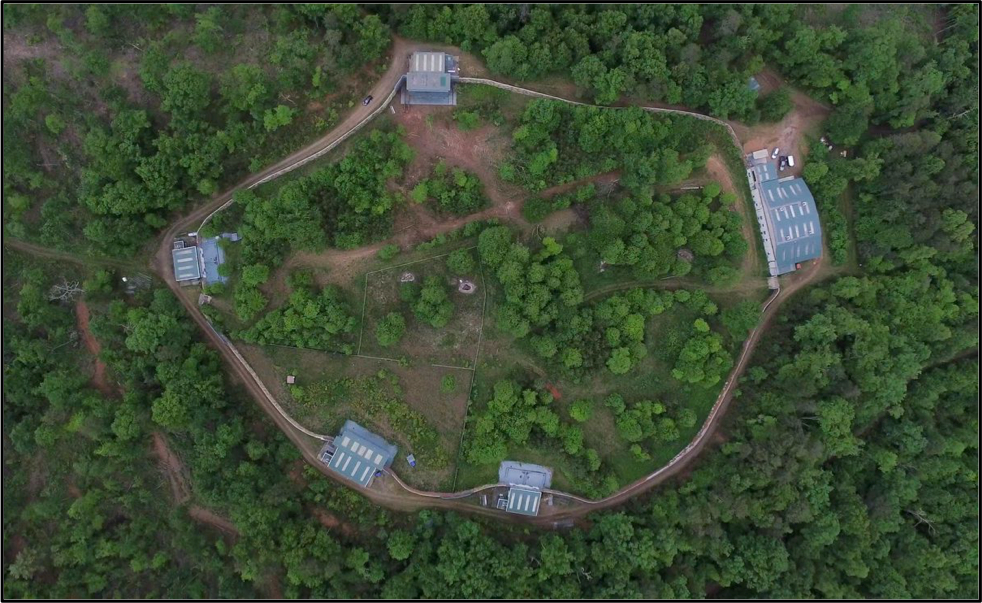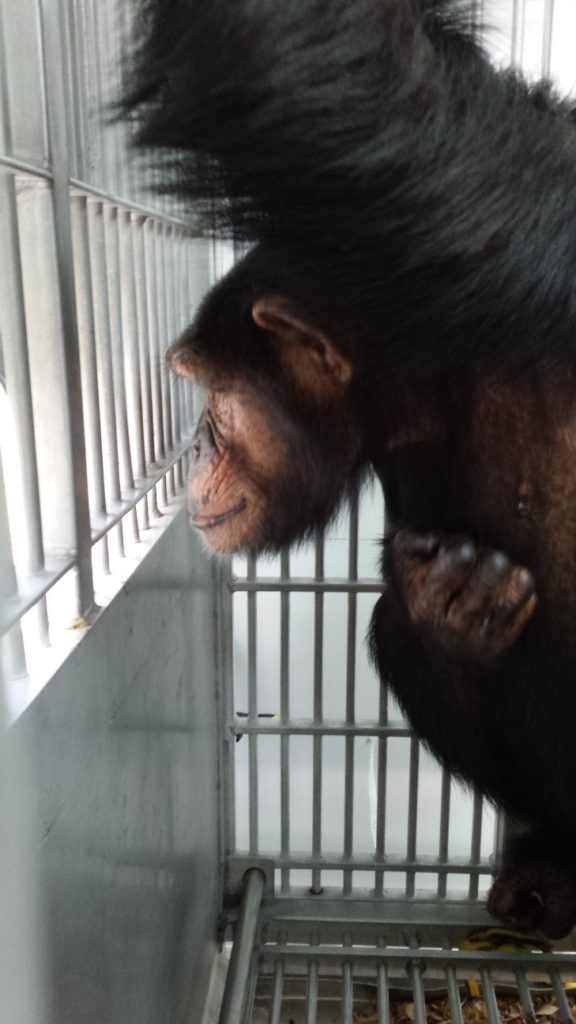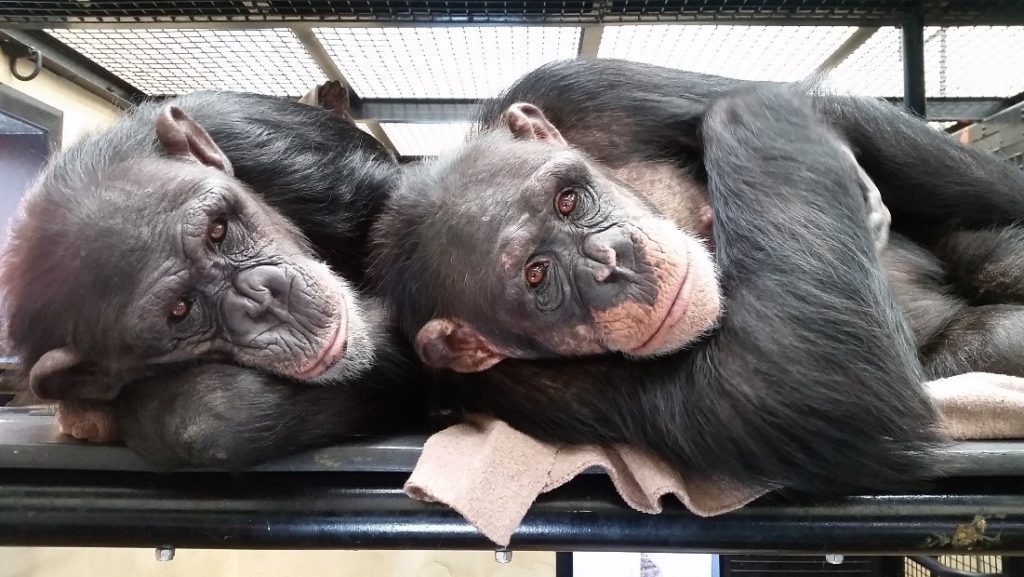
Project Chimps From the Beginning

By Bruce Wagman
Project Chimps was founded five years ago due to the commitment of prominent animal protection lawyer Bruce Wagman and a small group of passionate advocates and generous donors. At the fifth anniversary of the sanctuary’s founding, Bruce, now president of the Project Chimps Board of Directors, looks back at the hard-fought early victories and at what we’ve accomplished for research chimpanzees since 2014.
I am sitting in the Atlanta airport after visiting the 59 chimpanzees currently living at Project Chimps, and the jaw-dropping beauty of their sanctuary home in Blue Ridge, Georgia. It is five years ago that Project Chimps began, and a good time to reflect on this important milestone.
This inspiring, life-serving, exciting organization began as a big, some would say unrealistic, dream — and today it is a reality exceeding every hope and expectation of its founders.
Let me recall how we got here.

Chimpanzees in research
By early 2014, many Americans were working to end the use of chimpanzees in invasive research in U.S. laboratories. And while the legal wheels were in motion to accomplish that goal, in 2014 chimpanzees could still be used in research.
So we had a crazy idea – let’s see if we can convince the laboratory housing the largest number of privately-owned chimpanzees to turn them over to us, so we could place them in a sanctuary setting, ending any possibility of further research.
It was audacious, but we had nothing to lose – we could only be turned down – and everything to gain: the retirement of over 200 chimpanzees who were at the time living at the New Iberia Research Center (NIRC).
A visit to New Iberia, Louisiana
So we went to New Iberia, Louisiana, and met with the people who kept the chimps there. We met with the president of the University of Louisiana (UL), and the university’s lawyer, because NIRC is part of UL. I must say I couldn’t believe that we had made it that far, to actually be talking about the possibility of all the NIRC chimpanzees coming to Project Chimps. And I expected them to just reject the idea.
But they did not turn us down.
They told us that if we could prove our ability to actually accomplish this gigantic undertaking, then they would work with us. One day and two meetings changed everything my life would ever mean.
It also changed the lives of the hundreds of humans who would support Project Chimps, who would work there (almost ten times as many volunteers as staff at this point, with the volunteers engaged in every aspect of the sanctuary’s operations), and who would fall in love with the chimpanzees and follow their stories. And most important, of course, that day changed the entire world for hundreds of former research chimpanzees.
A surprising answer
The NIRC officials said yes! It was hard to process. So “all” we had to do was form an organization, find a property, find staff and build a volunteer program. Oh, and find financial backing that would, over the life of the sanctuary, need to be more than one hundred million dollars. Yes, it would cost that much to feed, house, love, support, entertain, and provide comfort for all those chimpanzees, most of whom would live five decades or more.
I remember returning to the hotel room in shock. What just happened? The largest private facility housing biomedical research chimpanzees in the world had just told advocates for an end to chimpanzee research, that they would retire the chimpanzees to our sanctuary. Our dream could come true, if we could just put all of the pieces in place.
Now what?
Of course, we did not have a sanctuary yet. And though they told us they would consider entering into a contract to turn the chimpanzees over to our group, we did not have a group. Not even a name. There was no reason to have an organization formed, because if the NIRC leaders had turned us down, Project Chimps probably never would have started.
Still standing dumbfounded in the hotel room in 2014, I reflected on the years leading up to this day. I had worked on a number of legal matters to help chimpanzees and get them out of abusive situations, had worked with other chimpanzee sanctuaries, and assisted several of the groups that had been fighting for the end to chimpanzee research for years.
And now we were being offered a chance at getting this large group of chimpanzees to a sanctuary. Just for the asking. It was exciting, extremely frightening, and a major call to action.

Mobilizing support for the chimps
The first thing we did was call a few trusted friends, who we knew cared about animals, and chimpanzees, enough to put their heart and soul into making this happen. They were both on board with the idea, and in less than two months we came up with our name and started looking for a home for hundreds of chimpanzees.
When we found the perfect location – a former gorilla sanctuary with 236 forested acres in the Blue Ridge Mountains of north Georgia – The Humane Society of the United States stepped up and helped to secure the property and provide critical operating funds.

Getting folks on board
Gradually, our supporters grew in number. Celebrities and other philanthropists generously backed our cause and thousands of people began following our stories on social media, donating what they could to help feed and enrich the sanctuary’s first chimpanzees.

That was the beginning. The rest is contemporary history – magic for our chimpanzees – and a life-altering series of events for hundreds if not thousands of people. As I write this, 59 chimpanzees have the opportunity to roam the forest at Project Chimps and 30 more are slated to join them by year-end. But then our current housing area will be full, and we will need to build new buildings and habitats for the remaining (over 100) chimpanzees waiting to move to Project Chimps.
Realizing the vision
Over
the next five years, we’ll work to expand Project Chimps to bring the remaining
chimpanzees still waiting in the lab. We are grateful to NIRC leaders for their
ongoing cooperation as we organize the capital campaign to raise tens of
millions of dollars to fulfill our founding vision.

One day, our dream will be realized, and we’ll wake up to a brand new day with true sanctuary for each and every one of those chimpanzees. If ever there was an example of the old adage, “where there’s a will, there’s a way,” Project Chimps is it.

Bruce Wagman is an animal lawyer, an expert strategist, and a true friend to animals. He is a lawyer in the San Francisco office of national law firm Riley Safer Holmes & Cancila and has an almost-exclusive focus on a wide range of animal law matters, including litigation, education, legislative counseling, and consultation. He has practiced animal law since 1992 and represented clients in state and federal courts as well as regulatory and administrative proceedings. Bruce’s clients include numerous animal protection organizations as well as private individuals. He is a coeditor of Animal Law, the first animal law casebook, and is a coauthor of A Worldview of Animal Law, which provides a broad perspective on animal law around the world. He has taught animal law since 1996 and currently teaches at three Bay Area law schools. Bruce was a founding board member of Chimpanzee Sanctuary Northwest and has advised members of the chimpanzee sanctuary community on a wide range of legal issues. He is a founder of Project Chimps and currently serves as president of the sanctuary’s board of directors.
